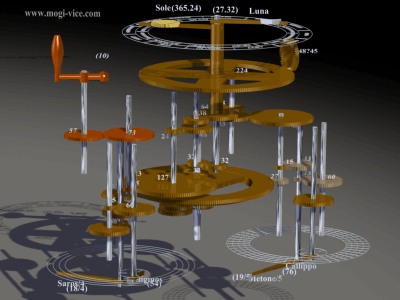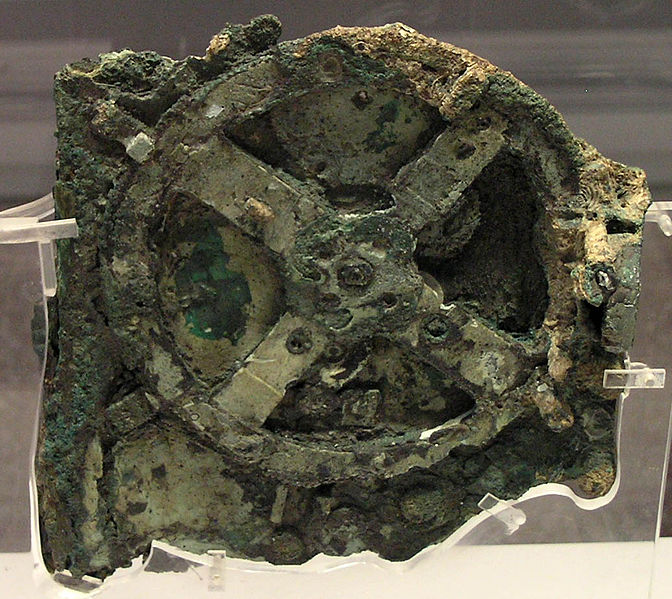Between 1900 and 1901, divers salvaging the wreck of the Antikythera, an archeological undertaking, as this was an ancient wreck, discovered what to all intents and purposes was a mechanical computer of great age, obviously constructed with the aim of calculating astronomical positioning. At the time, it was barely realized how very unusual this was, because, with a date of construction estimated at between 100 and 150 years before Christ, this artifact should have been impossible to build. The sophistication shown in the design and building was comparable with the technologies developed by19th century Swiss clock makers, while most known astronomical clocks began appearing in the 14th century. No satisfactory explanation for this advanced mechanism has yet appeared, but this incredibly rare and exciting object must, in truth, be priceless in terms of value.
The mechanism is the oldest known complex scientific calculator. It contains many gears, and is sometimes called the first known analog computer, although its flawless manufacturing suggests that it may have had a number of undiscovered predecessors during the Hellenistic Period. It appears to be constructed upon theories of astronomy and mathematics developed by Greek astronomers and it is estimated that it was made around 150-100 BC.
Consensus among scholars is that the mechanism itself was made in the Greek-speaking world. All the instructions of the mechanism are written in Koine Greek. One hypothesis is that the device was constructed at an academy founded by the Stoic philosopher Posidonius on the Greek island of Rhodes, which at the time was known as a center of astronomy and mechanical engineering, and that perhaps the astronomer Hipparchus was the engineer who designed it since it contains a lunar mechanism which uses Hipparchus's theory for the motion of the Moon. However, the most recent findings of The Antikythera Mechanism Research Project, as published in the July 31, 2008, edition of Nature alternatively suggest that the concept for the mechanism originated in the colonies of Corinth, which might imply a connection with Archimedes.
Nothing like this instrument is preserved elsewhere. Nothing comparable to it is known. from any ancient scientific text or literary allusion. On the contrary, from all that we know of science and technology in the Hellenistic Age we should have felt that such a device could not exist. Some historians have suggested that the Greeks were not interested in experiment because of a contempt-perhaps induced by the existence of the institution of slavery-for manual labor. On the other hand it has long been recognized that in abstract mathematics and in mathematical astronomy they were no beginners but rather "fellows of another college" who reached great heights of sophistication. Many of the Greek scientific devices known to us from written descriptions show much mathematical ingenuity, but in all cases the purely mechanical part of the design seems relatively crude. Gearing was clearly known to the Greeks, but it was used only in relatively simple applications. They employed pairs of gears to change angular speed or mechanical ad- vantage, or to apply power through a right angle, as in the water-driven mill.

Even the most complex mechanical devices described by the ancient writers Hero of Alexandria and Vitruvius contained only simple gearing. For example, the taximeter used by the Greeks to measure the distance travelled by the wheels of a carriage employed only pairs of gears (or gears and worms) to achieve the necessary ratio of movement. It could be argued that if the Greeks knew the principle of gearing, they should have had no difficulty in constructing mechanisms as complex as epicyclic gears. We now know from the fragments in the National Museum that the Greeks did make such mechanisms, but the knowledge is so unexpected that some scholars at first thought that the fragments must belong to some more modern device.
More on Antikythera Mechanism
The mechanism is the oldest known complex scientific calculator. It contains many gears, and is sometimes called the first known analog computer, although its flawless manufacturing suggests that it may have had a number of undiscovered predecessors during the Hellenistic Period. It appears to be constructed upon theories of astronomy and mathematics developed by Greek astronomers and it is estimated that it was made around 150-100 BC.
Consensus among scholars is that the mechanism itself was made in the Greek-speaking world. All the instructions of the mechanism are written in Koine Greek. One hypothesis is that the device was constructed at an academy founded by the Stoic philosopher Posidonius on the Greek island of Rhodes, which at the time was known as a center of astronomy and mechanical engineering, and that perhaps the astronomer Hipparchus was the engineer who designed it since it contains a lunar mechanism which uses Hipparchus's theory for the motion of the Moon. However, the most recent findings of The Antikythera Mechanism Research Project, as published in the July 31, 2008, edition of Nature alternatively suggest that the concept for the mechanism originated in the colonies of Corinth, which might imply a connection with Archimedes.
Nothing like this instrument is preserved elsewhere. Nothing comparable to it is known. from any ancient scientific text or literary allusion. On the contrary, from all that we know of science and technology in the Hellenistic Age we should have felt that such a device could not exist. Some historians have suggested that the Greeks were not interested in experiment because of a contempt-perhaps induced by the existence of the institution of slavery-for manual labor. On the other hand it has long been recognized that in abstract mathematics and in mathematical astronomy they were no beginners but rather "fellows of another college" who reached great heights of sophistication. Many of the Greek scientific devices known to us from written descriptions show much mathematical ingenuity, but in all cases the purely mechanical part of the design seems relatively crude. Gearing was clearly known to the Greeks, but it was used only in relatively simple applications. They employed pairs of gears to change angular speed or mechanical ad- vantage, or to apply power through a right angle, as in the water-driven mill.

Even the most complex mechanical devices described by the ancient writers Hero of Alexandria and Vitruvius contained only simple gearing. For example, the taximeter used by the Greeks to measure the distance travelled by the wheels of a carriage employed only pairs of gears (or gears and worms) to achieve the necessary ratio of movement. It could be argued that if the Greeks knew the principle of gearing, they should have had no difficulty in constructing mechanisms as complex as epicyclic gears. We now know from the fragments in the National Museum that the Greeks did make such mechanisms, but the knowledge is so unexpected that some scholars at first thought that the fragments must belong to some more modern device.
More on Antikythera Mechanism


No comments:
Post a Comment